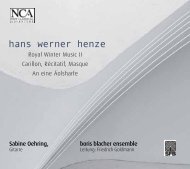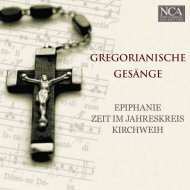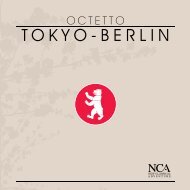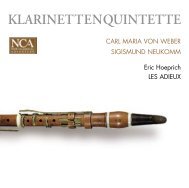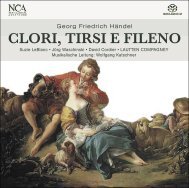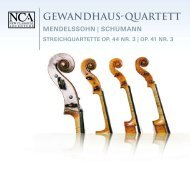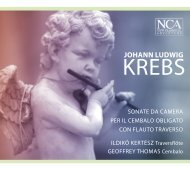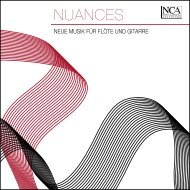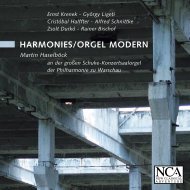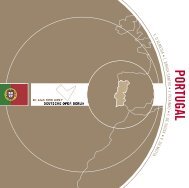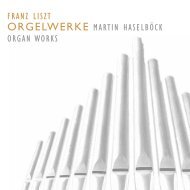CHRISTOPH SCHAFFRATH - nca - new classical adventure
CHRISTOPH SCHAFFRATH - nca - new classical adventure
CHRISTOPH SCHAFFRATH - nca - new classical adventure
Create successful ePaper yourself
Turn your PDF publications into a flip-book with our unique Google optimized e-Paper software.
Christoph<br />
sChaffrath<br />
Ouvertüre A-Dur • Flötenkonzert e-Moll • Sinfonie Nr. XIII g-Moll<br />
Cembalokonzert Es-Dur • Ouvertüre a-Moll<br />
1
2<br />
(p) 1995 musikakademie rheinsberg gmbh<br />
(c) membran music ltd.<br />
Aufgenommen / recorded: november 1995, St. laurentiuskirche rheinsberg<br />
Produzent / Producer: Klaus feldmann<br />
Aufnahme / recording: KammertonStudiO Berlin<br />
tonmeister / Sound editor: maria Suschke<br />
toningenieur / Sound engineer: christian ulrich<br />
cD-gesamtkonzeption, text und redaktion /<br />
Overall cD concept, text and editing: musikakademie rheinsberg gmbh<br />
geschäftsführung und künstlerische leitung /<br />
Management and artistic direction: dr. ulrike liedtke<br />
fotos / Photos: Werbepractic, henningsdorf / uwe Kämpfe, Berlin<br />
marc hufnagel, neuruppin<br />
<strong>CHRISTOPH</strong> <strong>SCHAFFRATH</strong><br />
(1709-1763)<br />
Ouvertüre A-Dur für Streicher unD BASSO cOntinuO<br />
Overture in A mAjOr fOr StringS And BASSO cOntinuO<br />
1 Largo – Allegro – Largo 7:01<br />
2 Allegro 3:23<br />
flötenkOnzert e-MOll für trAverSflöte, Streicher unD BASSO<br />
cOntinuO<br />
flute cOncertO in e minOr fOr trAnSverSe flute, StringS And BASSO<br />
cOntinuO<br />
3 Allegretto 3:48<br />
4 Andante 3:29<br />
5 Vivace 2:41<br />
SinfOnie nr. Xiii g-MOll für Streicher unD BASSO cOntinuO<br />
SymphOny nO. Xiii in g minOr fOr StringS And BASSO cOntinuO<br />
6 Allegro non tanto 4:24<br />
7 Andante 3:57<br />
8 Allegro 3:25<br />
3
4<br />
ceMBAlOkOnzert eS-Dur für ceMBAlO-SOlO unD Streicher<br />
hArpSichOrd cOncertO in e flAt mAjOr fOr hArpSichOrd SOlO And<br />
StringS<br />
9 Allegro 6:53<br />
0 Andante 6:37<br />
ß Allegro 5:27<br />
Ouvertüre A-MOll für Streicher unD BASSO cOntinuO<br />
Overture in A minOr fOr StringS And BASSO cOntinuO<br />
q Largo – Allegro – Largo 10:07<br />
w Allegro 3:50<br />
Total Time: 65:17<br />
kOnrAD hünteler, Traversflöte / transverse flute<br />
ArMin thAlheiM, Cembalo und Basso continuo / harpsichord and basso continuo<br />
hOwArD ArMAn, Basso continuo (3-5)<br />
hÄnDelfeStSPielOrcheSter DeS OPernhAuSeS hAlle<br />
DIRIGENT/CoNDuCToR: hOwArD ArMAn<br />
Aufführungspraktische Einrichtung des Notenmaterials / Adaptation of sheet music<br />
for performance: Hartmut Grosch<br />
hÄnDelfeStSPielOrcheSter DeS OPernhAuSeS hAlle<br />
viOline i / viOlin i<br />
lutz gÄBler Steffen Nowak, nach Stradivari, Bristol 1993<br />
DietlinD vOn POBlOzki Anonymus, ca. 1740<br />
tOni SchuMAnn Andreas Kempten, Dillingen 1740<br />
Annette lehMAnn Hopf-Familie, Vogtland ca. 1750<br />
viOline ii / viOlin ii<br />
hAnS gette Anonymus, Füssen ca. 1690<br />
AngelikA trieMer-BülOw Antonio Compostano, Milano 1695<br />
wilfrieD Schulze Anonymus, Vogtland ca. 1770<br />
Birgit SchnurPfeil Anonymus, Mitteldeutschland ca. 1760<br />
viOlA / viOlA<br />
hArtMut neuBert Steffen Nowak, nach Stradivari, Bristol 1991<br />
gerD DOering Frieder Schödel, nach Stradivari, Dresden 1977<br />
BernhArD PrOkein Anonymus, Böhmen ca. 1790<br />
viOlOncellO / viOlOncellO<br />
hAnS rüDiger hulSch Leonardus Maussiell, Nürnberg 1744<br />
(Leihgabe des Händelhauses Halle)<br />
JOhAnneS hArtMAnn Anonymus, Böhmen ca. 1850<br />
5
6<br />
kOntrABASS / DOuBle BASS<br />
clAuS-Peter neBelung Fünfsaitiger Kontrabass von<br />
Mathias Thier, Wien 1783<br />
(Leihgabe des Vereins der Freunde<br />
und Förderer der Händelfestspiele<br />
Halle e.V.)<br />
ceMBAlO / hArPSichOrD<br />
ArMin thAlheiM Sassmann, nach Pascal Taskin 1769,<br />
zweimanualig, Hückeswagen-Wiehagen<br />
1993<br />
OBOe / OBOe<br />
günter StrOBelt H. P. Westermann, nach oberländer,<br />
Köln 1994<br />
luiS cAcereS-MOncADA H. P. Westermann, nach oberländer,<br />
Köln 1994<br />
fAgOtt / BASSOOn<br />
frAnk BenkenDOrf G. Wolf, nach Eisenmenger,<br />
Kronach 1991
Deutsch<br />
8<br />
<strong>CHRISTOPH</strong> <strong>SCHAFFRATH</strong> –<br />
Cembalist bei Friedrich II.<br />
„die kronprinzliche Kapelle bestand damals schon aus den geschicktesten tonkünstlern.<br />
die beyden gebrüder graun, zwey Brüder Benda, hr. chart, hr. Blume, hr. grunke<br />
spielten die violine, hr. hock das violoncell, hr. janisch das lautenviolon, hr. petrini<br />
die harfe, hr. Baroni die theorbe, hr. reich die Bratsche, hr. Schaffrath den flügel<br />
und zwey Waldhornisten, worunter hr. horgitzky war.“ 1 Gemeint ist die Rheinsberger<br />
Hofkapelle vom „jungen fritz“, immerhin mit einer gut ausgestatteten Streicherbesetzung.<br />
Die Flöte blies der Kronprinz persönlich, am Hammerflügel oder Cembalo<br />
saß Christoph Schaffrath. Man musizierte in der „music Kammer“ des Rheinsberger<br />
Schlosses, einem quer hinter dem Turmkabinett des Klingenberg-Flügels gelegenen,<br />
recht kleinen Raum.<br />
Ihren Anfang nahm die kompositorisch reiche Kapellentwicklung bereits zuvor in<br />
Ruppin. Johann Joachim Quantz, Flöten- und Kompositionslehrer von Friedrich, hatte<br />
Schaffrath ebenso wie Georg Czarth (auch „Chart“), Carl Heinrich Graun und<br />
Johann Gottlieb Graun, Franz Benda und Johann Georg Benda nach dem Tode von<br />
August dem Starken aus dessen Dresdener Hofkapelle in das märkische Ruppin empfohlen.<br />
Hier befehligte der Kronprinz 1732-1736 ein Regiment und ließ einen Garten<br />
mitsamt „Amalthea“-Musentempel zum Lesen, Musizieren und Dinieren errichten.<br />
Als Friedrich 1736 mit seiner Gemahlin das Rheinsberger Schloss bezog, folgten ihm<br />
die Musiker und begründeten die „rheinsberger hofkapelle“. Für vier Jahre erlebte<br />
9
10<br />
Rheinsberg eine Blütezeit vorklassischer Musik. Offiziell befasste sich der Thronfolger<br />
mit militärwissenschaftlichen, literarischen und geisteswissenschaftlichen<br />
Studien – was er ja auch tat: Im Turmkabinett schrieb Friedrich Briefe an Voltaire,<br />
1738 entstanden seine Betrachtungen über den gegenwärtigen Zustand europas<br />
und 1739 legte er seine Herrscherauffassung und politisch-moralische Prinzipien<br />
im Antimachiavell nieder. Für das Flötespiel fanden sich dennoch Zeit, gute Musiker<br />
und Freunde – aber nicht alles musste an das väterliche Ohr dringen!<br />
Oft bleibt ungewiss, ob Kompositionen von Schaffrath und den anderen Musikern<br />
nun in Ruppin oder Rheinsberg entstanden. Das uns heute vorliegende Notenmaterial<br />
weist die Hofkapell-Musiker nicht nur als Virtuosen auf ihren Instrumenten<br />
aus, sondern zeigt auch ihren jugendlichen Drang nach neuen Spieltechniken und<br />
Ausdrucksmöglichkeiten zwischen auslaufenden barocken Kompositionsverfahren<br />
und späterer „mannheimer Schule“. So gilt denn unsere Aufmerksamkeit bisher<br />
unbekannten Kompositionen von Mitgliedern der Rheinsberger Hofkapelle, die in<br />
Ruppin und Rheinsberg als Komponisten die musikgeschichtliche Phase der „Berliner<br />
Schule“ einleiteten. Als Musiker zogen sie im Rang eines „capell-Bedienten“ mit<br />
dem neuen König in Berlin ein und bildeten den Grundstock der Staatskapelle in der<br />
von Friedrich II. gegründeten Lindenoper.<br />
Christoph Schaffrath kam 1734 nach Ruppin und blieb für gut zehn Jahre Cembalist<br />
bei Friedrich II. Über Schaffraths musikalischen Ausbildungsweg ist wenig bekannt.<br />
In einem Bewerbungsschreiben vom 2. Juni 1733 2 um die vakante Organistenstelle<br />
der Sophienkirche in Dresden berichtet er selbst von einer dreijährigen Tätigkeit als<br />
Cembalist und Komponist bei August dem Starken sowie bei dem polnischen Fürsten<br />
Sanguszko. Schaffraths Bewerbung blieb erfolglos. Wilhelm Friedemann Bach bekam<br />
die ersehnte Dresdener Stelle. Schaffrath ging nach Ruppin und Rheinsberg, 1740<br />
folgte er dem König Friedrich II. nach Berlin. Vermutlich bewarb sich bereits 1738<br />
ein anderer Cembalist in Rheinsberg mit speziell für Friedrich komponierten Flötenkonzerten<br />
– Carl Philipp Emanuel Bach. Erst 1741 trat Bach als 1. Cembalist in die<br />
Dienste des Königs, Schaffrath blieb als 2. Cembalist – um 100 Taler höher bezahlt<br />
als Bach! – in der Königlichen Kapelle. 1744 ließ Friedrich II. eigens für Schaffrath<br />
eine Stelle als „clavicembalist und cammermusikus“ bei seiner Schwester, Prinzessin<br />
Amalie, in Berlin einrichten. Schaffrath gewann Freiraum zum Komponieren und<br />
Unterrichten, er verfasste in seinen letzten Lebensjahren den Entwurf zu einem<br />
Lehrbuch der Musik. Zu Schaffraths Aufgaben gehörte es auch, die Bibliothek der<br />
Prinzessin durch Kopien neuer Kompositionen zu ergänzen – so befinden sich in den<br />
Beständen der ehemaligen Amalienbibliothek (heute in der Staatsbibliothek Berlin)<br />
zahlreiche Autographe von Schaffraths Hand. Hartmut Grosch weist in einem Verzeichnis<br />
der Kompositionen von Schaffrath 15 Sinfonien, 16 Ouvertüren, 40 Klavier-<br />
bzw. Cembalokonzerte, 8 Konzerte für verschiedene Soloinstrumente (Violine, Flöte,<br />
Oboe, Fagott), 44 Duette für unterschiedliche Besetzungen, 24 Trios, 14 Quartette,<br />
Sonaten, Partiten und mehr als 20 Solostücke für Cembalo nach. 62 Werke befinden<br />
sich in der Amalienbibliothek, die Kompositionen auf dieser CD wurden gut 250<br />
Jahre nach ihrer Entstehung erstmalig von Grosch wiederentdeckt.<br />
11
12<br />
Die Ouvertüre in A-Dur entstand im Geist der barocken Französischen Ouvertüre,<br />
ohne jedoch deren Satzfolge langsam-schnell-langsam pur zu übernehmen. Eine<br />
feierlich-pathetische Einleitung in punktiertem Rhythmus eröffnet die Ouvertüre<br />
(A) und wird von dem fugiert verarbeiteten Allegrothema (B) abgelöst. Zweimal<br />
fällt das Allegro thematisch in das Largo zurück (AABA‘BA‘). Der zweite Ouvertüren-<br />
Satz springt munter in der Dreiklangsmotivik eines tänzerischen Allegros im Zweivierteltakt<br />
– unbekümmerte Musizierfreude bestätigt den ideenreichen Melodiker<br />
Schaffrath.<br />
Eher kammermusikalisch legte Schaffrath das flötenkOnzert in e-MOll an.<br />
Durchhörbarkeit und Klarheit des Klanges als erstrebtes Ziel führten zur typisch<br />
norddeutschen Dünnstimmigkeit. Erste und zweite Violine werden bis auf wenige<br />
Tutti-Stellen unisono geführt. Um so exponierter kann das Soloinstrument brillieren.<br />
Obwohl Schaffrath die Flöte in seinen Kammermusiken häufig einsetzte, ist das<br />
e-Moll-Konzert sein einziges bisher bekanntes Flötenkonzert. Gleich vier verschiedene<br />
musikalische Gedanken exponiert das Allegretto. Ganz dem Stil der „empfindsamen“<br />
Musik geschuldet, entfaltet sich das Andante mit einem Trio aus Flöte,<br />
Violoncello und Cembalo im Mittelteil. Typisch „berlinisch“ (sagen wir ruhig auch:<br />
„ruppin-rheinsbergisch“) mögen den Zeitgenossen die Flöteneskapaden des Vivace<br />
erschienen sein, wurde doch die Flöte als Instrument in der ersten Hälfte des<br />
18. Jahrhunderts erst richtig konzertfähig, weil sie ein König blies. Das handschriftliche<br />
Manuskript des Flötenkonzertes befindet sich in der Mecklenburgischen Landesbibliothek<br />
zu Schwerin.<br />
Die SinfOnie nr. Xiii in g-MOll lässt mit einiger Phantasie vieles hören, was<br />
musikgeschichtlich durch die „mannheimer Schule“ eingebracht wurde – die Herausbildung<br />
eines zweiten Themas im ersten Satz, dynamische Nuancierungen, Seufzer,<br />
Vögelchen und die Orchester-Walze. Auch wenn der Generalbass im zweiten<br />
Satz verstummen würde, ergäbe es ein sinnvolles, kapriziös-zartes Andante. Freilich<br />
folgt Schaffrath noch dem Typus der alten neapolitanischen Sinfonia, und motivisch-thematische<br />
Arbeit im klassischen Sinne findet noch nicht statt. Dafür tritt<br />
stilistische Experimentierfreude um so mehr zutage, als wir um die Neuerungen bis<br />
hin zu einer frühen Mozart-Sinfonie wissen. Der nahe liegende Vergleich ändert<br />
nichts an der Eigenständigkeit einer musikalischen Phase zwischen bekannten Eckpunkten.<br />
Christoph Schaffrath lohnt mit seiner Musik die Entdeckung.<br />
Das ceMBAlOkOnzert in eS-Dur gehört neben weiteren vier Cembalokonzerten<br />
zum Klingenberg-Nachlass in der Amalienbibliothek. Nur 17 der insgesamt 40<br />
Cembalokonzerte überstanden den 2. Weltkrieg unbeschadet. Eine von Schaffrath<br />
handgeschriebene, verzierte Fassung des Adagios seines B-Dur-Konzertes zeugt von<br />
der hohen Virtuosität des Interpreten Schaffrath und gab wesentliche Anhaltspunkte<br />
für die aufführungspraktische Einrichtung des Es-Dur-Konzertes. So scheinen<br />
kunstvolle Verzierungen des Soloparts Vorrang gegenüber formaler Architektur einzunehmen.<br />
Das Konzert ist dreisätzig, die Ecksätze modifizieren die Ritornellform<br />
des barocken Solokonzertes. Im Allegro erscheint das Tutti-Thema sequenziert und<br />
geteilt, der Cembalist verarbeitet das thematische Material in freien Spielfiguren.<br />
Dramatisch geben sich die drei Tutti-Akkorde am Beginn des Andante, geradezu<br />
13
14<br />
klassischem Ausdruckswillen geschuldet und kontrastierend zum empfindsam angelegten<br />
Cembalopart. Spritzig und überaus virtuos zeigt sich das abschließende<br />
Allegro mit seinen fünf Ritornellen. Schaffrath notierte den Cembalopart lediglich<br />
ein- oder zweistimmig – eine durchaus übliche Praxis im 18. Jahrhundert, außerdem<br />
spielte er selbst und ersparte sich die Mühen der Notation. Umfangreiche aufführungspraktische<br />
Kenntnisse der Musik des 18. Jahrhunderts sind notwendig, um die<br />
Mehrstimmigkeit im Cembalopart auszufüllen, Akkorde in Skalenläufe umzusetzen<br />
und die stilgerechte Ornamentik zu finden.<br />
In der Anlage ähnelt die Ouvertüre in A-MOll der A-Dur-Ouvertüre. Während<br />
das Largo Seufzermotivik als vorklassische Stilelemente enthält, stellt sich Schaffrath<br />
im Allegro des ersten Satzes als geübter Kontrapunktiker dar. Wenn Johann Joachim<br />
Quantz den „vermischten Stil“ 3 als typisches Merkmal der „Berliner Schule“<br />
bezeichnet und in erster Linie den Einfluss der mannigfaltigen, kühnen italienischen<br />
Erfindungen neben der transparenten französischen Musizierhaltung meint, so<br />
stehen hier zugleich barocke Stilelemente mit größter Selbstverständlichkeit neben<br />
denen der „galanten“ Musik, wie sie Carl Philipp Emanuel Bach zugeschrieben<br />
wird.<br />
Die MuSikAkADeMie rheinSBerg stellt sich seit ihrer Gründung 1991 die Aufgabe,<br />
in Vergessenheit geratenen Kompositionen von Mitgliedern der Rheinsberger<br />
Hofkapelle zu neuem Leben zu verhelfen. Zahlreiche Konzerte im Spiegelsaal des<br />
Rheinsberger Schlosses und in der St. Laurentiuskirche, eine erste Buchpublikation<br />
die rheinsberger hofkapelle von friedrich ii. – musiker auf dem Weg zum Berliner<br />
capell-Bedienten (1995), Noten-Urtextausgaben in Zusammenarbeit mit dem Verlag<br />
fejA und CD-Produktionen fegen den Staub von alten Noten und lassen gute<br />
Musik erklingen – eine Lücke in der Musikgeschichte, die Anfänge der „Berliner<br />
Schule“, schließt sich allmählich.<br />
„Schaffrath ist der Welt durch seine schönen und überall beliebten Kompositionen,<br />
wovon verschiedene für den flügel durch den druck gemein gemacht wurden, bekannt<br />
genug“ 4 , schrieb Friedrich Wilhelm Marpurg noch am Ende des 18. Jahrhunderts.<br />
Mögen die wahrhaft schönen musikalischen Gedanken des Cembalisten<br />
Christoph Schaffrath ihren Weg zurück in die Musikwelt finden.<br />
Dr. Ulrike Liedtke<br />
1 Nicolai, Friedrich: Beschreibung des Lustschlosses und Gartens Sr. Königl. Hoheit des Prinzen Heinrich, Bruder des<br />
Königs, zu Rheinsberg wie auch der Stadt und der Gegend um dieselbe, Berlin 1778; Nachdruck hg. v. der Generaldirektion<br />
der Staatlichen Schlösser und Gärten Potsdam-Sanssouci, Potsdam 1985, S. 21.<br />
2 Schaffrath, Christoph: Brief vom 2. Juni 1733 im Stadtarchiv Dresden, Aktenband Sektion III, Kap. VII, Nr. 67,<br />
Abdruck in: Grosch, Hartmut: „Christoph Schaffrath – Komponist, Cembalist, Lehrmeister“, in: Die Rheinsberger<br />
Hofkapelle von Friedrich II. – Musiker auf dem Weg zum Berliner ‚Capell-Bedienten’, hg. v. ulrike Liedtke, Musikakademie<br />
Rheinsberg 1995, S.203–240.<br />
3<br />
vgl. Quantz, Johann Joachim: Versuch einer Anweisung, die Flöte traversiere zu spielen, Faksimile-Nachdruck der<br />
Ausgabe Berlin 1752, Kassel 1983, S. 332.<br />
4<br />
Marpurg, Friedrich Wilhelm: Historisch-Kritische Beyträge zur Aufnahme der Musik, Faksimile-Nachdruck der<br />
Ausgabe 1754-1778 Hildesheim, New York 1970, Bd. 1, S. 157.<br />
15
16<br />
DAS hÄnDelfeStSPielOrcheSter DeS OPernhAuSeS hAlle<br />
Das Händelfestspielorchester gehört zum Orchester des Opernhauses Halle (Chefdirigent:<br />
Johan M. Arnell), dem größten und zugleich traditionsreichsten Orchester<br />
Sachsen-Anhalts, dessen Geschichte bis weit ins 18. Jahrhundert zurückreicht.<br />
Das einstige Landestheater Halle (aus dem das Opernhaus Halle im Januar 1992<br />
hervorging) war die Wiege der Händel-Festspiele, die seit 1952 alljährlich in Halle<br />
stattfinden und vom damaligen Chefdirigenten Horst-Tanu Margraf (gemeinsam<br />
mit dem Regisseur Heinz Rückert und dem Szenographen Rudolf Heinrich) maßgeblich<br />
initiiert wurden. In den 80er Jahren gewann die Hallesche Händelopern-<br />
Rezeption an internationaler Ausstrahlung, ein Verdienst des Dirigenten Christian<br />
Kluttig und des Regisseurs Peter Konwitschny, die in dieser Zeit sehr produktiv zusammenarbeiteten.<br />
Große Bedeutung kam der praktischen Umsetzung musikwissenschaftlicher<br />
Kenntnisse über die Londoner Aufführungspraxis der Händel-Zeit<br />
zu. Man bemühte sich, dem barocken Klangideal auf dem verfügbaren modernen<br />
Instrumentarium möglichst nahe zu kommen. Mit der Händel-Oper Orlando – der<br />
50. (!) Händel-Inszenierung des Opernhauses Halle, die im Rahmen der 42. Händel-<br />
Festspiele 1993 zur Premiere gebracht wurde, gingen die Musiker des Händelfestspielorchesters<br />
erstmals noch einen Schritt weiter, indem sie historisches Instrumentarium<br />
verwendeten. Damit begann die künstlerische Zusammenarbeit mit dem<br />
Dirigenten Howard Arman, welche die Entwicklung des Händelfestspielorchesters<br />
nachhaltig beeinflusste und eine kontinuierliche Fortsetzung in Konzerten (Köln,<br />
Innsbruck, Halle), Opernproduktionen (flavio 1994; Semele 1995) und einer ersten<br />
Händelfestspielorchester unter den Kolonnaden des Rheinsberger Schlosses<br />
17
18<br />
CD (Opernarien und Instrumentalsätze aus Händel-Opern, produziert für Capriccio<br />
gemeinsam mit dem Countertenor Axel Köhler) fand. Das Orchester plant weitere<br />
Projekte unter Leitung von Howard Arman.<br />
hOwArD ArMAn<br />
wurde in London geboren und erhielt seine Ausbildung am Trinity College of Music.<br />
Nach erfolgreicher Tätigkeit bei führenden Ensembles seiner Heimat übersiedelte<br />
er zunächst nach München. Es folgten Engagements in ganz Europa – u. a. bei<br />
Festspielen in Salzburg, Paris, Berlin, Madrid, Amsterdam und in Jerusalem. Arman<br />
lebt seit 1985 in Österreich und ist Professor an der Hochschule Mozarteum in Salzburg.<br />
Zahlreiche Schallplatten- und Rundfunkaufnahmen sowie eine Reihe eigener<br />
Werkausgaben bestätigen seine besonderen Aktivitäten im Bereich der Alten Musik.<br />
Armans Affinität zur Chormusik artikuliert sich in einer Reihe von Aufführungen und<br />
Aufnahmen, die mit dem Norddeutschen Rundfunkchor in Hamburg und mit dem<br />
RIAS-Kammerchor Berlin entstanden. Für die Gründung des Salzburger Bachchores<br />
und seine langjährige Zusammenarbeit mit diesem Ensemble wurde Arman 1994 mit<br />
Wiens Ferdinand-Großmann-Preis ausgezeichnet. Howard Arman ist Künstlerischer<br />
Leiter der Schütz-Akademie in Thüringen sowie seit 1991 Intendant der Festwochen<br />
der Alten Musik in Innsbruck. Die Barock-Oper stellt einen weiteren Schwerpunkt<br />
in Armans Tätigkeit dar, insbesondere das Werk Händels. So dirigierte er u. a.<br />
Serse, Alcina (dafür erhielt er den Internationalen Radiopreis für Alte Musik) und die<br />
Händelopern-Produktionen des Opernhauses Halle der Jahre 1993 (Orlando), 1994<br />
(flavio) und 1995 (szenische Produktion des Oratoriums Semele).<br />
kOnrAD hünteler<br />
studierte bei Aurèle Nicolet und Hans-Martin Linde, anschließend ging er für drei<br />
Jahre als Soloflötist nach Kapstadt/Südafrika. Seit dem Erwerb einer originalen Traversflöte<br />
von F. G. A. Kirst, einem Flötenbauer von Friedrich II., gilt Hüntelers besonderes<br />
Interesse dem Spiel historischer Flöteninstrumente. Er musizierte als Solist<br />
und Kammermusiker mit fast allen namhaften Ensembles für Alte Musik, u. a. mit<br />
dem Collegium Aureum, der Cappella Coloniensis, der Academy of Ancient Music,<br />
dem English Concert und dem Amsterdam Baroque Orchestra. Den London Classical<br />
Players unter der Leitung von Roger Norrington war Hünteler sechs Jahre lang als<br />
Soloflötist verbunden, die gleiche Position hat er seit nunmehr vierzehn Jahren im<br />
Orchestra of the Eighteenth Century unter der Leitung von Frans Brüggen inne.<br />
19
20<br />
Zu den zahlreichen Aufnahmen mit dem Solisten und Kammermusiker Hünteler<br />
gehören die Gesamteinspielung der Flötenkonzerte und -sonaten von Carl Philipp<br />
Emanuel Bach mit dem Amsterdam Baroque Orchestra unter Ton Koopman bzw.<br />
mit Anner Bylsma und Jacques Ogg, die trockenen Blumen von Franz Schubert mit<br />
Melvyn Tan, die drei Klaviertrios mit Flöte von Joseph Haydn mit Christoph Coin<br />
und Patrick Cohen, die zwölf Fantasien für Flöte Solo von Georg Philipp Telemann,<br />
Flötenkonzerte von Mozart mit dem Orchestra of the Eighteenth Century sowie<br />
Flötenkonzerte von Vivaldi und Franz Benda mit der Camerata des 18. Jahrhunderts.<br />
Besondere Beachtung fand der erste Teil der Gesamtaufnahme von Telemanns<br />
tafelmusik, die jüngst unter Konrad Hüntelers Leitung mit der von ihm gegründeten<br />
Camerata des 18. Jahrhunderts erschien.<br />
Konrad Hünteler ist Künstlerischer Leiter des Barockfestes Münster und Münsterland<br />
und der „Musik an Westfälischen Adelshöfen“. Auch als Herausgeber älterer<br />
Flötenmusik trat Hünteler in den letzten Jahren hervor. Seit fünfzehn Jahren leitet<br />
Hünteler eine Flöten-Hauptfachklasse an der Musikhochschule in Münster, an der<br />
er seit sechs Jahren auch barocke und klassische Traversflöte unterrichtet. Hünteler<br />
gibt zahlreiche Meisterkurse im In- und Ausland, u. a. an der Musikakademie<br />
Rheinsberg.<br />
ArMin thAlheiM<br />
studierte zunächst Kirchenmusik in Dresden, danach in Leipzig Orgel bei Robert Köbler<br />
und Hannes Kästner, Klavier bei Mathilde Erben und Günther Kootz sowie Cembalo<br />
in Berlin an der Akademie der Künste bei Hans Pischner. Bereits während seines<br />
Studiums nahm Thalheim erfolgreich an Orgel- und Improvisationswettbewerben in<br />
Prag, Leipzig und Weimar teil und wurde 2. Preisträger des Internationalen Johann-<br />
Sebastian-Bach-Wettbewerbes im Fach Cembalo. Seine aufführungspraktischen<br />
Kenntnisse vervollkommnete er in Meisterkursen bei Zuzana Ruzickova in Prag und<br />
Zürich, bei Huguette Dreyfus in St. Maximin, bei Kenneth Gilbert, Ewald Kooiman<br />
und Werner Jakob in Haarlem (Niederlande), bei Gustav Leonhardt in Köln und Johann<br />
Sonnleitner in Innsbruck. Nach einigen Jahren als Kantor und Korrepetitor in<br />
Berlin entwickelte Thalheim eine vielseitige Konzerttätigkeit als Solist, Duopartner<br />
und Continuospieler, die ihn bis heute in fast alle Länder Europas, nach Indien,<br />
Japan, Mexiko und Kuba führte. Thalheim widmet sich vornehmlich der Interpretation<br />
Alter Musik auf historischen Tasteninstrumenten nach aufführungspraktischen<br />
Erkenntnissen. Improvisationen, zeitgenössische Werke und eigene Kompositionen<br />
setzen besondere Akzente in seinen Konzerten.<br />
Zahlreiche CD-, Radio- und Fernsehproduktionen dokumentieren Thalheims Können,<br />
u. a. erschienen von ihm eingespielt Cembalo-Werke Johann Sebastian Bachs<br />
und der Virginalisten, die Cembalokonzerte Johann Sebastian Bachs gemeinsam mit<br />
Christine Schornsheim und dem Neuen Bachischen Collegium Musicum unter der<br />
Leitung von Burkhard Glaetzner, Flötensonaten von Carl Philipp Emanuel Bach mit<br />
Eckart Haupt und Siegfried Pank sowie Clavichord-Sonaten von Carl Philipp Emanuel<br />
Bach. Seit 1974 unterrichtet Armin Thalheim an der Musikhochschule „Hanns<br />
Eisler“ in Berlin, anfangs Improvisation, heute Cembalo, Generalbass und Kammermusik.<br />
Armin Thalheim gibt zahlreiche Meisterkurse, u. a. an der Musikakademie<br />
Rheinsberg, in deren Beirat er mitwirkt.<br />
21
englisch<br />
<strong>CHRISTOPH</strong> <strong>SCHAFFRATH</strong> –<br />
Harpsichordist to Frederick II<br />
“Already in those days the Kapelle (orchestra) of the crown prince was composed of<br />
the most skilled musicians. Both the graun brothers, the two Benda brothers, herr<br />
chart, herr Blume and herr grunke played the violin, the violoncello was played by<br />
herr hock, the lute violon by herr janisch, the harp by herr petrini, the theorbo by<br />
herr Baroni, the cello by herr reich, herr Schaffrath was on the grand piano and<br />
there were two hunting hornists – one being herr horgitzky.” 1 The passage refers<br />
to the Rheinsberg Court Kapelle of the ‘young fritz’ (Frederick II), which at least<br />
had a good string section. The crown prince, personally, was on the flute and at<br />
the hammerflugel or the harpsichord sat Christoph Schaffrath. They played in the<br />
‘music room’ of Rheinsberg Schloss, a rather small room behind the Turmkabinett<br />
(the tower room) in the Klingenberg wing of the castle.<br />
The formation of the Kapelle took advantage of the highly developed musical<br />
scene that already existed in Ruppin. Earlier, after the death of August the Strong,<br />
Schaffrath as well as Georg Czath (also known as ‘Chart’), Carl Heinrich and Johann<br />
Gottlieb Graun, and Franz and Johann Georg Benda who had all played in the<br />
Dresden Court Kapelle, had been recommended to Frederick by Johann Joachim<br />
Quantz, his flute and composition tutor, and they subsequently moved to Ruppin.<br />
Here between 1732 and 1736 the crown prince commanded a regiment to lay out<br />
a garden and to construct a pavillion dedicated to the pursuits of reading, music,<br />
22 23
and dining. When in 1736 Frederick and his consort moved into the Rheinsberg<br />
Schloss he was followed by the musicians who founded the ‘rheinsberg court<br />
Kapelle’. For four years Rheinsberg experienced a flowering of pre<strong>classical</strong> music.<br />
Officially the heir to the throne was occupied with studying military science,<br />
literature and the humanities, and this he did. Sitting in the Turmkabinett he wrote<br />
letters to Voltaire and in 1738 he published his Observations on the contemporary<br />
situation in europe and in 1739 he set out his ruling principles on politics and<br />
morality in Antimachiavell. There was still time for flute playing, good musicians<br />
and friends, “but not everything should come to the fatherly ears!”<br />
It is often unclear if compositions of Schaffrath and the other musicians come<br />
from Ruppin or from Rheinsberg. The musical manuscripts that we can see today<br />
show that the musicians from the court Kapelle were not just virtuosos on their<br />
instruments but showed their youthful yearning for <strong>new</strong> playing techniques<br />
and possibilities of expression that was leading them away from the baroque<br />
compositional methods and anticipating the later ‘mannheim school’. This justifies<br />
our attention to previously unknown composers, members of the Rheinsberg Court<br />
Kapelle, who having worked in Ruppin and Rheinsberg lead us into the time of<br />
the ‘Berlin school’. As Frederick II ascended to the throne they moved with him to<br />
Berlin as ‘ensemble members’ and formed the basis of the State Orchestra in the<br />
Linden Opera that Frederick founded.<br />
Christoph Schaffrath arrived in Ruppin in 1734 and stayed a good ten years as<br />
Frederick’s harpsichordist. Little is known bout his musical education. On June<br />
the 2nd 1733 2 in a letter of application for the post of organist in the Sophien<br />
Church in Dresden he wrote about a three year job as harpsichordist and composer<br />
with August the Strong as well as with the Polish Count Sanguszko. Schaffrath’s<br />
application was unsuccessful – Wilhelm Friedemann Bach got the longed for job.<br />
Schaffrath went to Ruppin and Rheinsberg and in 1740 followed King Frederick<br />
to Berlin. It is thought that as early as 1738 another harpsichordist applied<br />
for the post in Rheinberg. This was Carl Philipp Emanuel Bach, he came with<br />
flute concerts specially composed for Frederick, but it was only in 1741 that he<br />
became 1st harpsichordist in the service of the king, Schaffrath remained as 2nd<br />
harpsichordist in the royal Kapelle, paid 100 talents more than Bach! In 1744<br />
Frederick II created a post for Schaffrath as ‘harpsichordist and chamber musician’<br />
with his sister Princess Amalie in Berlin. Schaffrath then had the time to compose<br />
and teach and in the last year of his life he wrote a draft for a textbook of music.<br />
One of Schaffrath’s tasks was to supplement the Princess’s library by the copying<br />
of <strong>new</strong> compositions – in the possession of the former Amalie Library (now in the<br />
State Library in Berlin) are many manuscripts in Schaffrath’s hand. Hartmut Grosch<br />
has shown, in a Catalogue of Schaffrath’s works, 15 symphonies, 16 overtures, 40<br />
piano and harpsichord concertos, 8 concertos for various solo instruments (violin,<br />
flute, oboe, bassoon), 44 duets for various arrangements, 24 trios, 14 quartets,<br />
sonatas, partitas and more than 20 solo compositions for the harpsichord. 62<br />
works can be found in the Amalie Library. The pieces on this CD were rediscovered<br />
by Grosch for the first time some 250 years after they were first composed.<br />
24 25
The Overture in A MAJOr arose from the spirit of the baroque French overture,<br />
although without the movements following the pure slow-fast-slow pattern. A<br />
solemn emotional introduction with a punctuated rhythm opens the overture (A)<br />
and is superseded by a fugue-like allegro theme (B). This allegro theme twice<br />
lapses back into the largo (AABA‘BA‘). The second movement of the overture leaps<br />
cheerfully into the common chord motif of a dance-like allegro in two-four time<br />
– this carefree musical joy confirming the creativity of Schaffrath the melodist.<br />
Schaffrath begins the flute cOncertO in e MinOr in a manner reminiscent<br />
of chamber music. The clarity and audibility are the desired goals and they lead<br />
to a typically light, airy north German sound. The first and second violin, except<br />
for a few moments tutti, play unisono. Alone and exposed the solo instruments<br />
can sparkle. Although Schaffrath often used the flute in his chamber music, the E<br />
minor concerto is his only known flute concerto.<br />
Four different musical ideas are shown in the allegretto. Completely indebted to<br />
the style of the ‘sensitive’ music, the andante unfolds in the middle section with a<br />
trio of the flute, violoncello and harpsichord. Although perhaps the flute segments<br />
in the vivace would have seemed typical ‘Berlin’ style (we could also easily say<br />
‘ruppin-rheinsberg’ style) to some contemporaries, the flute only really became<br />
an acceptable concert instrument in the first half of the 18th century because<br />
the king was playing it. The hand written manuscript of the flute concerto can be<br />
found in the Mecklenburg State Library in Schwerin.<br />
With a little imagination hints of the musical innovations that would be<br />
brought in by the ‘mannheimer school’ can be heard in the SyMPhOny nO. Xiii<br />
in g MinOr – a second theme being developed in the first movement, dynamic<br />
nuances, sighs, bird-calls and player rolls. Even when the basso continuo in the<br />
second movement goes silent, it produces a meaningful, capricious-delicate<br />
andante. Admittedly Schaffrath still follows the pattern of the old Neapolitan<br />
symphony and the development of motifs and themes in the <strong>classical</strong> sense has<br />
not yet appeared, but instead there is a distinct joy in stylistic experiment to<br />
be heard, that could at a stretch be compared with the early Mozart. However<br />
these sort of comparisons are invidious, because although it lies between two well<br />
known musical époques this music can stand by itself. Christoph Schaffrath and<br />
his music is worth discovering.<br />
The hArPSichOrD cOncertO in e flAt MAJOr, along with four other<br />
harpsichord concertos, belongs to the Klingenberg bequest in the Amalie Library.<br />
Only 17 of the 40 harpsichord concertos survived the 2nd world war undamaged.<br />
A decorated version of the adagio from the B major concerto, hand-written<br />
by Schaffrath himself bore witness to the great virtuosity of Schaffrath as an<br />
interpreter and gave essential clues to the arrangement of performances of the<br />
E flat major concerto. The artful ornamentation of the solo part seem to take<br />
precedence over the formal architecture of the piece. The concerto has three<br />
movements, the outer movements modify the ritornello form of the baroque<br />
solo concerto. In the allegro the tutti theme appears sequenced and divided, the<br />
harpsichordist uses the thematic material in free flourishes.<br />
26 27
The andante begins dramatically with three tutti chords which almost owe<br />
something to <strong>classical</strong> ways of expression and contrast to the sensitively calculated<br />
harpsichord part. The closing allegro is sparkling and extremely virtuoso with its<br />
five ritornellos. Schaffrath wrote just one or two voices in the harpsichord part, a<br />
typical practice in the 18th century, and he often played himself so saving himself<br />
the trouble of the notation. Extensive knowledge of the performance techniques<br />
and arrangements of the 18th century are needed to bring out the multi-layered<br />
nature of the harpsichord part, to set chords in scales and to find the appropriate<br />
style for the ornamentation.<br />
In its arrangement the Overture in A MinOr resembles the A major overture.<br />
While the largo has pre-<strong>classical</strong> stylistic elements in the form of sighing motifs,<br />
in the allegro of the first movement Schaffrath presents himself as a practised<br />
counterpointer. Johann Joachim Quantz says that the ‘mixed style’ 3 is the typical<br />
distinguishing feature of the ‘Berlin school’ and means primarily the influences, from<br />
one side, the diversity and boldness of the Italian developments and from the other<br />
the transparency of the French musical style; but at the same time it can be taken<br />
for granted that there are baroque elements next to the ‘gallant’ music ascribed to<br />
Carl Philipp Emanuel Bach.<br />
in the St. Laurentius Church, the publication of a book entitled the rheinsberg<br />
Kapelle of frederick ii – musicians on their way to becoming Berlin ‘capell-Bediente’<br />
(1995), the publication of manuscripts in collaboration with fejA publishing and the<br />
production of CD’s are all blowing the dust off old notes and allowing good music<br />
to be heard and in the process a gap in music history, that deals with the beginning<br />
of the ‘Berlin school’, is gradually being closed.<br />
“Schaffrath is known throughout the world for his beautiful compositions that are<br />
popular everywhere and some of which through printing have become available for<br />
the piano” 4 , wrote Friedrich Wilhelm Marpurg at the end of the 18th century. Would<br />
that the truly beautiful musical ideas of the harpsichordist Christoph Schaffrath<br />
find their way back into the music world.<br />
Dr. Ulrike Liedtke<br />
1 Nicolai, Friedrich, Description of the palaces and gardens of his highness Prince Heinrich, brother of the King,<br />
in Rheinsberg and its surroundings, Berlin 1778, reprinted under the guidance of the Staatlichen Schlösser und<br />
Gärten Potsdam-Sanssouci, Potsdam 1985, p. 21.<br />
2 Schaffrath, Christoph, letter of 2nd June 1733 in the State Archive Dresden reproduced in Grosch, Hartmut,<br />
“Christoph Schaffrath – composer, harpsichordist, teacher”, in: The Rheinsberg Kapelle von Friedrich II – musicians<br />
on their way to becoming Berlin ‘Capell-Bediente’, edited by ulrike Liedtke, Musikakademie Rheinsberg 1995, pp.<br />
203–240.<br />
Since its founding in 1991 the MuSikAkADeMie rheinSBerg has given itself<br />
the task of bringing back to life forgotten works from members of the Rheinsberg<br />
Court Kapelle. Countless concerts in the Spiegelsaal of the Rheinsberg Schloss and<br />
3<br />
Quantz, Johann Joachim, An attempt at a guide to playing the transverse flute, facsimile reprint of the edition<br />
from Berlin 1752, Kassel 1983, p. 332.<br />
4<br />
Marpurg, Friedrich Wilhelm, Historical-critical articles about the reaction to music, facsimile reprint of the edition<br />
1754-1778 Hildesheim, New York 1970, Bd. 1, p. 157.<br />
28 29
30<br />
the hÄnDel feStivAl OrcheStrA Of the hAlle OPerA hOuSe<br />
The Händel Festival Orchestra belongs to the orchestra of the Halle Opera House<br />
(Chief Conductor: Johan M. Arnell), the largest and at the same time most richly<br />
traditional orchestra in Sachsen-Anhalt, whose history goes right back into the 18th<br />
century.<br />
The former Landestheater Halle (which left the Opera House in Jan. 1992) was the<br />
cradle of the Händel Festival, that every year since 1952 had taken place in Halle.<br />
This event was founded by the Chief Conductor Horst-Tanu Margraf (together<br />
with the director Heinz Rücken and the set designer Rudolf Heinrich). In the 80’s,<br />
thanks to the productive teamwork of conductor Christian Kluttig and the director<br />
Peter Konwitschny, the Halle Händel Opera won an international reputation. The<br />
practical application of music scholarship which revealed the authentic qualities<br />
of the performance of works from the Händel era in London assumed a greater<br />
importance. Care was taken to produce as closely as possible the real baroque sound<br />
with the available modern instruments. In 1993 at the 42nd Händel Festival the<br />
Händel opera Orlando was premiered, this was the 50th setting of Händel’s operas<br />
in the Halle Opera House, and the musicians went a step further by using historical<br />
instruments. This was the beginning of an artistic collaboration with the conductor<br />
Howard Arman who has since then been an influence on the development of the<br />
Händel Festival Orchestra, the collaboration has continued with concerts (Cologne,<br />
Innsbruck, Halle), opera productions (flavio 1994, Semele 1995) and a first CD<br />
(Movements from Händel operas, produced for Capriccio together with the counter<br />
tenor Axel Köhler). The orchestra is planning further projects under the leadership<br />
of Howard Arman.<br />
hOwArD ArMAn<br />
was born in London and trained at Trinity College of Music. After successful periods<br />
with leading ensembles in his homeland he next moved to Munich. Then followed<br />
engagements across the whole of Europe, amongst others festivals in Salzburg,<br />
Paris, Berlin, Madrid, Amsterdam and Jerusalem. Arman has lived in Austria since<br />
1985 and is Professor at the Hochschule Mozarteum in Salzburg. His involvement<br />
31
in the area of ancient music is demonstrated by countless records and broadcasts.<br />
Arman’s affinity to choir music comes out in his performances and recordings for<br />
the Norddeutsche Radio Choir in Hamburg and with the RIAS Chamber Choir in<br />
Berlin. His founding of, and long-standing collaboration with the Salzburg Bach<br />
Choir won him Vienna’s 1994 Ferdinand Großmann Prize. Howard Arman is the<br />
Artistic Director of the Schütz Academy in Thüringen as well as Director of the<br />
Festival Week of Ancient Music in Innsbruck. Baroque opera is another main focus<br />
of Arman’s activities, especially Händel’s work. He has directed amongst others,<br />
Serse, Alcina (for this he won the International Radio Prize for Ancient Music) and<br />
Händel productions at the Halle Opera House – Orlando (1993), flavio (1994) and a<br />
scenic production of the oratorio Semele (1995).<br />
kOnrAD hünteler<br />
studied with Aurele Nicolet and Hans-Martin Linde, afterwards going to Cape<br />
Town, South Africa as a solo flautist. Since the acquisition of an original transverse<br />
flute made by F.G.A. Kirst, a flute maker to Frederick II, Hünteler’s special interest<br />
has been the playing of historical instruments. He has played with just about all<br />
the famous ensembles for ancient music, for example the Collegium Aureum, the<br />
Capella Coloniensis, the Academy of Ancient Music, the English Concert and the<br />
Amsterdam Baroque Orchestra. For six years Hünteler was involved with the London<br />
Classical Players under the direction of Roger Norrington, he has also been a solo<br />
flautist for more than fourteen years with the Orchestra of the Eighteenth Century<br />
lead by Frans Brüggen.<br />
Among the countless recordings of this soloist and chamber musician are the<br />
complete flute concerts and flute sonatas by Carl Philipp Emanuel Bach performed<br />
with the Amsterdam Baroque Orchestra under Ton Koopman, Anner Bylsma and<br />
Jacques Ogg, the dry flowers by Franz Schubert with Melvyn Tan, the three piano<br />
trios with flute by Joseph Haydn with Christopher Coin and Patrick Cohen, the<br />
twelve fantasies for solo flute by Georg Philipp Telemann, flute concerts by Mozart<br />
with the Orchestra of the Eighteenth Century as well as flute concerts by Vivaldi and<br />
Franz Benda with the Camerata des 18. Jahrhunderts. Special attention was paid to<br />
the first part of the complete recording of Telemanns table music, the earliest piece<br />
recorded under Hünteler’s direction by the Camerata des 18. Jahrhunderts which<br />
he himself founded. Konrad Hünteler is the artistic director of the Münster and<br />
Münsterland Baroque Festival and the ‘Musik an Westfälischen Adelshöfen’ (Music<br />
in Westphalian Noble Courts). Hünteler has also stood out recently as a publisher<br />
of ancient flute music. For the last fifteen years Hünteler has lead a specialist flute<br />
class at the Musikhochschule in Münster, where he has also for the last six years<br />
taught baroque and <strong>classical</strong> transverse flute. He gives countless master classes in<br />
and outside Germany, one of these being at the Musikakademie Rheinsberg.<br />
ArMin thAlheiM<br />
first studied church music in Dresden, and then organ in Leipzig with Robert<br />
Köbler and Hannes Kästner, piano with Mathilde Erben and Günther Kootz and also<br />
harpsichord in Berlin at the Akademie der Künste with Hans Pischner. Already while<br />
he was studying he was successfully taking part in organ and organ improvisation<br />
32 33
34<br />
competitions in Prague, Leipzig and Weimar and he was also 2nd prize winner in<br />
the harpsichord section at the International Johann Sebastian Bach Competition.<br />
He perfected his performing abilities in masterclasses with Zuzana Ruzickova in<br />
Prague and Zurich, Huguette Dreyfus in St. Maximin, with Kenneth Gilbert, Ewald<br />
Kooiman and Werner Jakob in Haarlem (Netherlands), with Gustav Leonhardt in<br />
Köln and Johann Sonnleitner in Innsbruck. After some years as choirmaster and<br />
coach in Berlin Thalheim developed a broad concert talent as a soloist, duet partner<br />
and continuo player that up until now has taken him to most of the countries<br />
in Europe, India, Japan, Mexico and Cuba. Thalheim dedicates himself principally<br />
to the interpretation of ancient music on historical keyboard instruments in the<br />
authentic, original style. His concerts are also given further depth by improvisation,<br />
contemporary works and by his own compositions. Countless CD, radio and<br />
television document Thalheim’s skills, amongst others he gives a perfectly resolved<br />
performance of harpsichord works by Johann Sebastian Bach, the harpsichord<br />
concerts by Bach together with Christine Schornsheim and the New Bach Collegium<br />
Musicum under the leadership of Burkhard Glaetzner, flute sonatas by Carl Philipp<br />
Emanuel Bach with Eckart Haupt and Siegfried Pank as well as clavichord sonatas<br />
by Carl Philipp Emanuel Bach.<br />
Since 1974 Armin Thalheim has taught improvisation, harpsichord, basso continuo<br />
and chamber music. Armin Thalheim gives countless master classes including at the<br />
Musikakademie Rheinsberg, where he also works on the advisory council.<br />
(translation: tim davies)<br />
Française
<strong>CHRISTOPH</strong> <strong>SCHAFFRATH</strong> –<br />
claveciniste à la cour de Frédéric II<br />
« la chapelle du prince héritier était d’ores et déjà composée des musiciens les plus<br />
habiles. les deux frères graun, deux frères Benda, m. chart, m. Blume, m. grunke<br />
jouaient du violon, m. hock du violoncelle, m. janisch du violone [lautenviolon], m.<br />
petrini de la harpe, m. Baroni du théorbe, m. reich de l’alto, m. Schaffrath du clavecin<br />
[flügel], et il y avait deux joueurs de cor dont m. horgitzky. » 1 Ladite chapelle est<br />
celle de la cour du « jeune fritz » à Rheinsberg, pourvue au moins d’un bel ensemble<br />
d’instruments à cordes. La flûte est tenue par le prince héritier en personne. Au<br />
pianoforte ou au clavecin se tient Christoph Schaffrath. Les séances musicales ont<br />
lieu dans la « music Kammer » (salle de musique), salle assez petite située derrière le<br />
cabinet de la tour de l’aile Klingenberg du château de Rheinsberg.<br />
Les débuts de cette chapelle qui s’apprêtait à développer une activité musicale riche<br />
et intense remontent à la période où Frédéric se trouvait à Ruppin. Dans cette petite<br />
ville dans la Marche du Brandebourg, où il commande un régiment de 1732 à 1736,<br />
le jeune prince héritier fait aménager un jardin et ériger un « temple d’Amalthée »,<br />
créant ainsi un espace destiné à la lecture, la musique, et les festins. C’est sur la<br />
recommandation de Johann Joachim Quantz, professeur de flûte et de composition<br />
du prince, que Frédéric fait venir à Ruppin, après la mort d’Auguste le Fort, plusieurs<br />
musiciens issus de la chapelle de la cour de Dresde dont Schaffrath, Georg Czarth<br />
(ou « chart »), Carl Heinrich Graun et Johann Gottlieb Graun, Franz Benda et Johann<br />
Georg Benda. Lorsqu’il s’installe avec son épouse dans le château de Rheinsberg en<br />
1736, Frédéric y emmène ses musiciens pour y constituer la « chapelle de la cour de<br />
rheinsberg ». Pendant quatre ans, une floraison de musique préclassique a lieu à<br />
Rheinsberg. Officiellement, le prince héritier fait des études de science militaire, de<br />
lettres et de sciences humaines – dans le cabinet de la tour, en réalité, Frédéric écrit<br />
des lettres à Voltaire, en 1738, il rédige ses Betrachtungen über den gegenwärtigen<br />
Zustand europas (Considérations sur l’état présent de l’Europe) et développe, dans<br />
l’Antimachiavell de 1739, sa conception du souverain et ses principes politiques et<br />
moraux. Si, malgré tout, il trouve le temps de pratiquer la flûte et des partenaires<br />
pour jouer avec lui, il ne faut surtout pas que cela vienne aux oreilles de son père !<br />
On hésite à dater de la période de Ruppin ou de celle de Rheinsberg de nombreuses<br />
compositions de Schaffrath et de ses collègues. Les partitions des musiciens de la<br />
chapelle de Frédéric qui nous sont parvenues ne témoignent pas seulement de leur<br />
virtuosité en tant qu’instrumentistes, mais aussi de leur quête juvénile de techniques<br />
de jeu et de formes d’expression nouvelles, qui se situe entre les procédés d’écriture<br />
baroque qui subsistent et les innovations de l’ « école de mannheim ». Notre<br />
attention se focalise ainsi sur les compositions jusqu’ici inconnues des membres de<br />
la chapelle de la cour de Rheinsberg dont les activités de compositeurs, à Ruppin et à<br />
Rheinsberg, inaugurent ce que l’histoire de la musique connaît sous le nom d’ « École<br />
berlinoise ». Lorsque le nouveau roi entre à Berlin, il emmène ses musiciens élevés au<br />
rang de « capell-Bediente » (employés à la chapelle), et c’est autour d’eux que va se<br />
constituer la Chapelle d’Etat de l’opéra Unter den Linden fondé par Frédéric II.<br />
36 37
Christoph Schaffrath arrive à Ruppin en 1734 et restera claveciniste auprès<br />
Frédéric II pendant une dizaine d’années. Au sujet de son parcours de formation<br />
musicale, les informations n’abondent pas. Dans sa lettre de candidature au poste<br />
d’organiste à l’église Ste-Sophie de Dresde datant du 2 juin 1733 2 , il déclare avoir<br />
servi pendant trois années Auguste le Fort ainsi que le prince polonais Sanguszko<br />
comme claveciniste et compositeur. Ce n’est pas lui mais Wilhelm Friedemann<br />
Bach qui obtient le poste prestigieux, alors que Schaffrath sera appelé à Ruppin<br />
d’où il passe à Rheinsberg, pour finir par suivre en 1740 le roi Frédéric II à Berlin.<br />
En 1738 déjà, un autre claveciniste semble avoir sollicité un poste à la cour<br />
de Rheinsberg, en proposant des concertos pour flûte écrits spécialement pour<br />
Frédéric : il s’agit de Carl Philipp Emanuel Bach. Mais ce n’est qu’en 1741 que<br />
Bach entre au service du roi en tant que 1er claveciniste alors que Schaffrath<br />
devient 2e claveciniste de la chapelle royale – ce qui n’empêche pas que son salaire<br />
soit 100 thaler plus élevé que celui de Bach ! En 1744, Frédéric fait créer pour<br />
Schaffrath le poste d’un « clavicembalist und cammermusikus » (claveciniste et<br />
musicien de chambre) à la cour de sa soeur, la princesse Amélie, à Berlin. Son<br />
emploi lui laisse le temps de composer, de donner des cours et de rédiger, dans ses<br />
dernières années, l’ébauche d’un lehrbuch der musik (Méthode de musique). De par<br />
sa fonction à la cour, il lui appartient, entre autre, de compléter la bibliothèque de<br />
la princesse en recopiant de nouvelles compositions. C’est ainsi que l’on retrouve<br />
parmi les réserves de l’ancienne Bibliothèque d’Amélie (conservées aujourd’hui à<br />
la Staatsbibliothek de Berlin) de nombreux manuscrits autographes de la main<br />
de Schaffrath. Dans son catalogue des œuvres de Schaffrath, Hartmut Grosch a<br />
répertorié 15 symphonies, 16 ouvertures, 40 concertos pour clavecin ou pianoforte,<br />
8 concertos pour différents instruments solistes (violon, flûte, hautbois, basson),<br />
44 duos pour différents instruments, 24 trios, 14 quatuors, plusieurs sonates et<br />
partite ainsi que plus de 20 morceaux pour clavecin solo. 62 œuvres se trouvent<br />
dans la Bibliothèque d’Amélie. Les oeuvres enregistrées ici ont été redécouvertes<br />
par Grosch plus de 250 ans après leur composition.<br />
Conçue dans l’esprit de l’ouverture baroque française, l’Ouverture en lA MAJeur<br />
ne s’en tient cependant pas strictement à la succession convenue des mouvements<br />
(lent-vif-lent). L’ouverture s’ouvre sur une introduction solennelle et pathétique (A),<br />
au rythme pointé, qui cède bientôt la place à un thème allegro traité en fugue (B).<br />
Par la suite, l’Allegro va revenir, à deux reprises, au thème du Largo (AABA‘BA‘).<br />
Le deuxième mouvement, un Allegro dansant en 2/4 bâti sur des motifs d’accords<br />
brisés, manifeste une joie de jouer insouciante et nous montre Schaffrath comme<br />
un inventeur de mélodies très imaginatif.<br />
Le cOncertO POur flûte en Mi Mineur relève d’une approche plutôt<br />
chambriste. Le souci de transparence et de clarté se traduit ici par une écriture<br />
dépouillée typique de la musique du nord de l’Allemagne. Du fait que les premiers et<br />
seconds violons jouent à l’unisson, sauf dans quelques passages de tutti, le soliste<br />
peut déployer sa virtuosité avec d’autant plus d’efficacité. Si la musique de chambre<br />
de Schaffrath fait souvent appel à la flûte, le Concerto en mi mineur est le seul<br />
concerto pour cet instrument du compositeur qui nous soit connu jusqu’à ce jour.<br />
38 39
L’Allegretto initial n’expose pas moins de quatres idées musicales. Tout empreint<br />
de style « sensible », l’Andante présente, dans sa section centrale, la flûte en trio<br />
avec le violoncelle et le clavecin. Aux oreilles des contemporains de Schaffrath, les<br />
capricieuses escapades que se permet la flûte dans le Vivace devaient sonner très<br />
« berlinois », du fait que la flûte venait juste de s’imposer, vers le milieu du XVIIIe<br />
siècle, comme instrument de concert, et non en dernier lieu grâce au roi-flûtiste<br />
prussien. Le manuscrit autographe du Concerto pour flûte est aujourd’hui conservé<br />
à la bibliothèque du Land de Mecklenburg à Schwerin.<br />
Dans la SyMPhOnie n° Xiii en SOl MAJeur, une oreille attentive saura<br />
identifier de nombreux éléments innovants apportés par les compositeurs de<br />
l’« école de mannheim », comme l’apparition d’un second thème dans le premier<br />
mouvement, la différenciation dynamique et certains effets tels que figures de<br />
soupir, « vögelchen » (« oisillons », motifs de trille rappelant les gazoullis d’oiseaux)<br />
et la célèbre « mannheimer Walze » (« rouleau », type de crescendo orchestral sur<br />
une note de pédale). Même si la basse continue se taisait complètement, le second<br />
mouvement ne se trouverait pas privé de sens musical et se présente toujours<br />
comme un Andante délicat et capricieux. Bien entendu, Schaffrath reste attaché<br />
au modèle de l’ancienne sinfonia napolitaine qui ne connaît pas encore le travail<br />
thématique au sens classique. En revanche, son approche est marquée par un<br />
goût de l’expérimentation stylistique d’autant plus remarquable si l’on considère<br />
l’évolution ultérieure du genre symphonique jusqu’aux premières œuvres de Mozart.<br />
Pour autant, si le parallèle s’impose, cela ne change rien au fait que nous avons<br />
affaire ici à une période autonome de l’histoire de la musique. Et la musique de<br />
Christoph Schaffrath vaut en tout cas d’être découverte.<br />
Le cOncertO POur clAvecin en Mi BéMOl MAJeur est l’un des cinq<br />
concertos pour clavecin qui se trouvent dans l’héritage Klingenberg faisant partie<br />
de la bibliothèque d’Amélie. Sur les quarante concertos pour clavecin de Schaffrath,<br />
seuls dix-sept ont survécu à la Seconde Guerre mondiale. Le manuscrit autographe<br />
d’une version ornementée de l’Adagio du Concerto en si bémol majeur témoigne de<br />
sa maîtrise virtuose de l’instrument et fournit des renseignements précieux pour<br />
l’interprétation du Concerto en mi bémol majeur. Il semble ainsi que Schaffrath ait<br />
privilégié l’ornementation élaborée de la partie de clavecin par rapport à l’aspect<br />
architectural de l’œuvre. Le concerto est en trois mouvements dont le premier et le<br />
dernier adoptent, sous une forme modifiée, la forme ritournelle du concerto baroque<br />
pour instrument soliste. Dans l’Allegro, le thème, d’abord exposé en tutti, réapparaît<br />
sous forme séquencée et subdivisée, le soliste puisant dans le matériau thématique<br />
une variété de figurations libres.<br />
Par leur allure dramatique, les trois accords tutti qui se trouvent au début de l’Andante<br />
relèvent d’une volonté d’expression qui semble préfigurer le classicisme, formant un<br />
contraste avec la partie de clavecin, de style plutôt « sensible ». Le mouvement final<br />
est un Allegro pétillant de virtuosité et scandé par cinq ritournelles. Schaffrath,<br />
étant lui-même le soliste exécutant, ne s’est pas astreint à noter complètement la<br />
partie de clavecin, de sorte que le manuscrit n’en donne le plus souvent qu’une ou<br />
deux voix, une pratique courante au XVIIIe siècle. Aussi l’interprète d’aujourd’hui<br />
40 41
doit-il posséder des connaissances approfondies afin de compléter les voix absentes<br />
dans le manuscrit de la partie de clavecin, de transformer en traits de gammes les<br />
accords notés et de réaliser une ornementation conforme au style de l’époque.<br />
De par sa disposition formelle, l’Ouverture en lA Mineur se rapproche de celle<br />
en la majeur. Dans le Largo, on trouve certains éléments du style préclassique tels<br />
que les motifs de soupirs, alors que, dans la partie Allegro du premier mouvement,<br />
Schaffrath témoigne d’une grande maîtrise du contrepoint. Si Johann Joachim<br />
Quantz, lorsqu’il parlait du « style mixte » (« vermischter Stil 3 ») comme d’une qualité<br />
typique de l’« école berlinoise », pensait surtout aux différentes influences nationales<br />
qu’elle fait siennes (l’audacieuse inventivité italienne et le souci français de la<br />
transparence), le « style mixte » de Schaffrath réunit de même, en toute désinvolture,<br />
les éléments des styles baroque et « galant » à la manière de Carl Philipp Emanuel<br />
Bach.<br />
Fondée en 1991, la MuSikAkADeMie rheinSBerg (Académie de musique de<br />
Rheinsberg) se propose de ramener à la vie l’héritage musical que nous ont laissé<br />
les musiciens-compositeurs de la chapelle de la cour de Rheinsberg. Ses activités<br />
comprennent l’organisation de concerts dans la Salle des glaces du château de<br />
Rheinsberg et dans l’église Saint-Laurent, la publication d’une monographie sur les<br />
musiciens de la chapelle de la cour de Rheinsberg (die rheinsberger hofkapelle<br />
von friedrich ii. – musiker auf dem Weg zum Berliner capell-Bedienten, 1995), la<br />
réalisation, en collaboration avec la maison d’édition fejA, de plusieurs éditions<br />
de texte original ainsi que des enregistrements sur CD. Retirant à la poussière des<br />
siècles un héritage musical largement inconnu, l’Académie de musique de Rheinsberg<br />
contribue en même temps à combler ce vide qu’ont constitué pendant longtemps,<br />
dans l’histoire de la musique, les débuts de l’« école de Berlin ».<br />
« Schaffrath est assez connu pour ses belles compositions généralement populaires,<br />
dont plusieurs pour le clavecin ont éte publiées en édition imprimée » 4 , écrivait<br />
Friedrich Wilhelm Marpurg à la fin du XVIIIe siècle. Que les belles idées musicales<br />
du claveciniste Christoph Schaffrath trouvent donc désormais leur place dans le<br />
monde musical !<br />
Dr. Ulrike Liedtke<br />
1 Friedrich Nicolai, Beschreibung des Lustschlosses und Gartens Sr. Königl. Hoheit des Prinzen Heinrich, Bruder des<br />
Königs, zu Rheinsberg wie auch der Stadt und der Gegend um dieselbe, rémpression de l’édition de Berlin 1778, éd.<br />
par la Generaldirektion der Staatlichen Schlösser und Gärten Potsdam-Sanssouci, Potsdam 1985, p. 21.<br />
2 Christoph Schaffrath dans une lettre du 2 juin 1733, conservée aux Archives de la ville de Dresde, section III,<br />
chap. VII, n° 67, cité d’après Hartmut Grosch, « Christoph Schaffrath – Komponist, Cembalist, Lehrmeister », in Die<br />
Rheinsberger Hofkapelle von Friedrich II. – Musiker auf dem Weg zum Berliner ‚Capell-Bedienten’, éd. par ulrike<br />
Liedtke, Musikakademie Rheinsberg 1995, p. 203-240.<br />
3<br />
Cf. Johann Joachim Quantz, Versuch einer Anweisung, die Flöte traversiere zu spielen, réimpression fac-simile de<br />
l’édition de Berlin 1752, Cassel, 1983, p. 332.<br />
4<br />
Friedrich Wilhelm Marpurg, Historisch-Kritische Beyträge zur Aufnahme der Musik, réimpression fac-simile de<br />
l’édition de Hildesheim 1754-1778, New York, 1970, vol. 1, p. 157.<br />
42 43
l’OrcheStre Du feStivAl hAenDel (hÄnDelfeStSPielOrcheSter)<br />
De l’OPérA De hAlle<br />
L’Orchestre du festival Haendel de Halle fait partie de l’orchestre de l’Opéra de Halle<br />
(directeur : Johan M. Arnell), qui est non seulement le plus grand orchestre du land<br />
de Saxe-Anhalt, mais aussi celui qui peut se vanter de la plus longue tradition, ses<br />
origines remontant au début du XVIIIe siècle.<br />
L’ancien Landestheater Halle (transformé en maison d’opéra et rebaptisé Opernhaus<br />
Halle en janvier 1992) est le berceau du festival Haendel qui se tient chaque année<br />
dans la ville depuis 1952 et dont la fondation est due essentiellement à l’initiative<br />
de Horst-Tanu Margraf, jadis directeur de l’orchestre du Landestheater (rejoint par<br />
le metteur en scène Heinz Rückert et le scénographe Rudolf Heinrich). Au cours des<br />
années 1980, les productions d’opéras de Haendel présentées à Halle ont bénéficié<br />
d’un rayonnement international grandissant grâce à la coopération particulièrement<br />
fructueuse entre le chef d’orchestre Christian Kluttig et le metteur en scène Peter<br />
Konwitschny. Dans ce contexte, la mise en application des résultats des recherches<br />
musicologiques sur la pratique d’exécution à Londres au temps de Haendel revêt<br />
une importance particulière. On cherche alors à s’approcher au plus près de l’idéal<br />
sonore de l’époque baroque tout en utilisant les instruments modernes. C’est avec<br />
la production de l’opéra Orlando de Haendel, présentée dans le cadre de la 42e<br />
édition du festival Haendel en 1993 et qui est en fait la cinquantième mise en scène<br />
de Haendel de l’Opéra de Halle, que l’Orchestre du festival Haendel franchit un pas<br />
décisif dans sa démarche artistique, jouant pour la première fois sur des instruments<br />
d’époque. Cette production signe aussi le début de la collaboration avec le chef<br />
44 45
d’orchestre Howard Arman qui va durablement marquer le développement artistique<br />
de l’orchestre et donne lieu à de nombreux concerts (Cologne, Innsbruck, Halle),<br />
productions d’opéras (flavio, 1994 ; Semele, 1995) et à un premier enregistrement<br />
sur CD (Airs d’opéras et musiques instrumentales extraites de divers opéras de<br />
Haendel avec le contre-ténor Axel Köhler, édité chez Capriccio). De nouveaux<br />
projets sous la direction de Howard Arman sont en préparation.<br />
hOwArD ArMAn<br />
est né à Londres et reçoit sa formation musicale au Trinity College of Music. C’est<br />
dans sa patrie anglaise qu’il entame sa carrière, travaillant avec des ensembles de<br />
premier plan, avant de quitter l’Angleterre pour s’établir à Munich. Dès lors, ses<br />
engagements le mènent à travers l’Europe, entre autres, au festival de Salzbourg,<br />
à Paris, Berlin, Madrid, Amsterdam ainsi qu’à Jérusalem. Depuis 1985, Arman vit<br />
en Autriche. Il est professeur au Mozarteum de Salzbourg. Une part importante de<br />
son activité est vouée à la musique ancienne, comme en témoignent de nombreux<br />
enreigstrements sur disque et pour la radio ainsi que les éditions musicales qu’il<br />
vient de publier. Sa passion pour la musique chorale a donné naissance à toute<br />
une série de concerts et d’enregistrements effectués avec le Chœur de la Radio<br />
nord-allemande (NDR) à Hambourg et avec le Chœur de chambre de la RIAS<br />
(RIAS-Kammerchor) de Berlin. En récompense de son travail, poursuivi pendant de<br />
longues années, avec le Chœur Bach de Salzbourg dont il est le fondateur, la ville<br />
de Vienne lui a décerné, en 1994, le prix Ferdinand Großmann. Howard Arman est<br />
directeur artistique de l’Académie Schütz en Thuringe et, depuis 1991, intendant<br />
du festival des Festwochen der Alten Musik à Innsbruck. Parmi les activités multiples<br />
de Howard Arman, l’opéra baroque occupe une place importante, son intérêt se<br />
portant surtout sur les œuvres de Haendel dont il a dirigé, entre autres, Serse, Alcina<br />
(récompensé du Prix Radio International pour la Musique Ancienne) et, à l’Opéra<br />
de Halle, Orlando (1993) et flavio (1994), ainsi qu’une production scénique de<br />
l’oratorio Semele (1995).<br />
kOnrAD hünteler<br />
fait ses études auprès d’Aurèle Nicolet et de Hans-Martin Linde. Il se rend ensuite à<br />
Kapstadt (en Afrique du Sud), où il travaille comme flûtiste solo pendant trois ans.<br />
Fasciné par les qualités d’une flûte traversière originale de F. G. A. Kirst (facteur de<br />
flûtes dont Frédéric II possédait plusieurs instruments) dont il a fait l’acquisition,<br />
il va développer un intérêt tout spécial pour les instruments d’époque. Konrad<br />
Hünteler s’est produit comme soliste et chambriste avec la plupart des ensembles<br />
renommés de musique ancienne dont le Collegium Aureum, la Cappella Coloniensis,<br />
The Academy of Ancient Music, The English Concert et l’Amsterdam Baroque<br />
Orchestra. Pendant six ans, il a été flûtiste solo des London Classical Players sous la<br />
direction de Roger Norrington. Depuis quatorze ans, il est membre de l’Orchestre du<br />
XVIIIe siècle de Frans Brüggen, également comme flûte solo.<br />
Parmi les nombreux enregistrements que Hünteler a réalisé comme soliste ou<br />
chambriste, citons à titre d’exemple l’intégrale des concertos et sonates pour<br />
flûte de Carl Philipp Emanuel Bach avec l’Amsterdam Baroque Orchestra sous la<br />
direction de Ton Koopman et avec comme partenaires Anner Bylsma et Jacques<br />
46 47
Ogg, les variations sur trockene Blumen de Franz Schubert avec Melvyn Tan, les trois<br />
pratique d’exécution historique, il a suivi les masterclasses de Zuzana Ruzickova à<br />
trios avec piano et flûte de Joseph Haydn avec Christoph Coin et Patrick Cohen, les<br />
Prague et à Zurich, de Huguette Dreyfus à St. Maximin, de Kenneth Gilbert, Ewald<br />
douze fantaisies pour flûte solo de Georg Philipp Telemann, des concertos pour flûte<br />
Kooiman et Werner Jakob à Haarlem (aux Pays-Bas), de Gustav Leonhardt à Cologne<br />
de Mozart avec l’Orchestre du XVIIIe siècle ainsi que des concertos pour flûte de<br />
et de Johann Sonnleitner à Innsbruck. Après avoir travaillé pendant quelques années<br />
Vivaldi et de Franz Benda avec la Camerata du XVIIIe siècle fondée par Hünteler en<br />
comme chantre et co-répétiteur à Berlin, Armin Thalheim a entamé une carrière<br />
personne. À souligner le premier volume, très acclamé, de l’intégrale des musiques<br />
de soliste, de chambriste (notamment en duo) et de continuiste. Sa vaste activité<br />
de table de Telemann avec la Camerata du XVIIIe siècle sous sa propre direction.<br />
de concerts l’a mené à travers toute l’Europe, aux Indes, au Japon, au Mexique et<br />
Konrad Hünteler est directeur artistique du festival baroque de Münster et du<br />
à Cuba. Au centre de son travail se place l’interprétation de musique ancienne sur<br />
Münsterland et du programme « Musik an Westfälischen Adelshöfen » (Musique<br />
des instruments à clavier historiques selon les pratiques d’exécution de l’époque.<br />
aux cours princières de la Westphalie). Outre cela, il a édité, ces dernières années,<br />
L’improvisation, la musique contemporaine et des œuvres de sa composition<br />
diverses œuvres de musique plus ancienne pour la flûte. Depuis quinze ans, Hünteler<br />
viennent enrichir sa programmation.<br />
est titulaire d’une classe de flûte à la Musikhochschule de Münster où il enseigne<br />
De nombreux enregistrements discographiques et radiotélévisés témoignent de ses<br />
aussi depuis six ans la flûte traversière baroque et classique. Hünteler donne des<br />
accomplissements artistiques. Sa discographie comprend entre autres des œuvres<br />
masterclasses en Allemagne et à l’étranger, entre autres, à l’Académie de musique<br />
pour clavecin de Jean Sébastien Bach et des virginalistes anglais, les concertos pour<br />
de Rheinsberg.<br />
clavecin de Jean Sébastien Bach avec Christine Schornsheim et le Neues Bachisches<br />
Collegium Musicum sous la direction de Burkhard Glaetzner, des sonates pour flûte<br />
ArMin thAlheiM<br />
de Carl Philipp Emanuel Bach avec Eckart Haupt et Siegfried Pank, ainsi que des<br />
a d’abord étudié la musique d’église à Dresde et ensuite l’orgue auprès de Robert<br />
sonates pour clavicorde de Carl Philipp Emanuel Bach. Depuis 1974, Armin Thalheim<br />
Köbler et Hannes Kästner et le piano auprès de Mathilde Erben et Günther Kootz<br />
enseigne à la Musikhochschule « Hanns Eisler » à Berlin, d’abord l’improvisation, à<br />
à Leipzig ainsi que le clavecin auprès de Hans Pischner à l’Académie des Arts à<br />
présent le clavecin, la basse continue et la musique de chambre. Armin Thalheim<br />
Berlin. Étudiant, il participa déjà à des concours d’orgue et d’improvisation à<br />
donne des masterclasses, entre autres, à l’Académie de musique de Rheinsberg dont<br />
Prague, Leipzig et Weimar et remporta le 2e prix pour le clavecin du Concours<br />
international Johann Sebastian Bach de Leipzig. Pour se perfectionner dans la<br />
il est membre du comité consultatif.<br />
(traduction: Babette hesse)<br />
48 49
die produktion der vorliegenden cd förderten:<br />
the production of this cd was sponsored by:<br />
ministerium für Wissenschaft, forschung und Kultur des landes Brandenburg<br />
Kunst- und Kulturverein rheinsberg (e.v.)<br />
Sparkasse Ostprignitz-ruppin<br />
Kurt-tucholsky-Buchhandlung, rheinsberg<br />
Arbeitergesangsverein rheinsberg<br />
privatbrauerei rheinsberg<br />
Bäckerei und Konditorei läge, rheinsberg<br />
ratskeller rheinsberg<br />
deutsche versicherungs-Aktiengesellschaft Allianz, hauptvertretung rheinsberg<br />
raumausstatter georg peter Wölk, rheinsberg<br />
elektro-Anlagen Schulze, rheinsberg<br />
maler gmbh rheinsberg<br />
zbo neustadt Baugesellschaft m.b.h.<br />
großhandel rainer Stirnemann, Storbeck<br />
elaSell Altruppin<br />
fruchthof neuruppin gmbh<br />
50 51



